
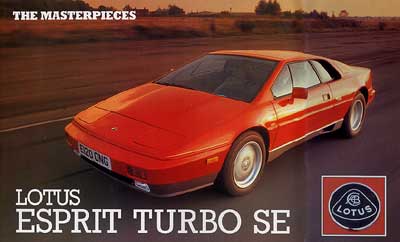
THE MASTERPIECES
Lotus Esprit Turbo SE
The Encyclopaedia of Supercars (1991)Lotus have achieved miracles with their Esprit, transforming it from its humble 160bhp origins more than a decade ago to its current status as a 264-bhp turbo intercooled supercar — the SE, capable of over 160 mph.
Today, with seven Grand Prix Constructor’ Championships and six Drivers’ Championships to the marques credit, but with founder Colin Chapman dead from a heart attack in December 1982, Lotus is part of the General Motors empire and building what many people think of as Britain’s nearest thing to a true supercar the Esprit Turbo SE.
The Esprit range for the 1990s, including a normally-aspirated option as well as the amazing Turbo, is a far cry from the build-it-yourself Lotuses of the early days, but its the sort of car Chapman had moved on to build from the early 1970s. It was the last production model, in fact, that Lotus introduced in Chapman’s lifetime.
Its spiritual ancestors were the front-engined Elite, introduced in 1957 as Lotus’s first CT-type coupe; the backbone-chassised, twincam-engined Elan, launched in 1962; the mid-engined Europa, first seen in 1966; and the new Lotus generation that started, just before the Esprit, with the front-engined and consciously upmarket new Elite and its sister, the Eclat.
In 1975, the launch of the Esprit brought all the classic Lotus hallmarks together: backbone chassis, glassfibre shell, and four-cylinder mid-engined layout; the difference was the more upmarket image, topped with styling by the highly respected Giorgetto Giugiaro. In fact, it was Giugiaro who approached Lotus during the 1971 Geneva Show and suggested that he might create a styling exercise on a Lotus chassis. It was built on a stretched and widened Europa chassis and had the wedge-shaped profile then so familiar on Grand Prix cars, emphasised by sharp edges and a dramatically raked windscreen. The Show car was so well received that Lotus adopted almost all the design, moving into the true prototype stage in 1973.
The most important change was chopping a couple of inches out of the wheelbase, on Chapman’s orders, which made the car look better balanced but at the expense of interior room for taller drivers. The Esprit was also given a virtually flat windscreen, a small lip spoiler under the nose and a slightly different tail profile, to improve high-speed stability. It lost its big engine cover in favour of a small lid. The shape was also modified to enable Lotus to mould the shell in two simple halves, top and bottom.
Launched in 1975, the Esprit was a sensation
The modified Europa chassis, of course, was replaced by a purpose-designed backbone, while the rear suspension was almost straight from the Elite, with the driveshafts used as the upper link for lightness — but unfortunately at the expense of rather nasty road noise. The engine was the new all-Lotus four-cylinder two-litre, designed to be canted over at 45 degrees, and the gearbox was the five-speed transaxle from Citroens Maserati-powered SM.
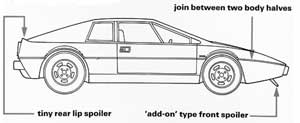
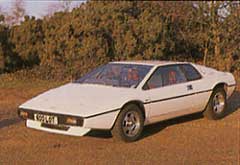
Launched at the Paris and London motor shows of 1975, the Esprit was a sensation. It was a lot more expensive than Lotus had planned, not so quick as had been predicted, and it had more than a few of the usual detail faults of low-volume-production cars in build quality and finish, but the dramatic shape guaranteed that people would take notice.
By 1980, when the first Turbo model made its debut, the world started to take the Esprit seriously as a supercar, albeit only a four-cylinder one. Its performance was excellent, with a top speed of over 150 mph and 0-60 acceleration in only 5.5 seconds, but even then not all the rough edges had been rounded off. That came with the latest in the line, the restyled Turbo Esprit of 1988. Giugiaros original sharp lines were smoothed out to produce a far more modern-looking design. This time Lotus did not go to Italy for inspiration; they found it in-house with their own Peter Stevens, now with McLaren.
Despite the old Turbo’s dramatic performance, it was decided that more had to be done to the car than just a cosmetic styling exercise (cosmetic because none of the car’s vital dimensions were changed under the advanced new glassfibre shell). Mechanical changes included a new Garrett T3 turbocharger to pressurise the twin Dellorto 45M carbs and a new, stronger transaxle from Renault (as used in the GTA) rather than Citroen, which gave slightly higher gearing.
The new and larger transmission meant that the rear brakes could no longer remain inboard-mounted and they migrated back to the conventional position on the wheel hubs, Lotus trading better cooling for greater unsprung weight compared with the inboard discs. The new package was an instant success; the body was stiffer, which made the suspension’s job that much easier, and quieter and more comfortable, which did the same for the driver.
To begin with there was no leap in performance to go with the new shape, but that was taken care of at a stroke with the launch of the SE (Special Equipment) model in 1989.
From ‘just’ 215 bhp Lotus upped the output of the 2174cc four to a staggering 264bhp at a stroke. The chief trick was the use of what Lotus called a ‘chargecooler’, or what everyone else would have called an intercooler. It was water-cooled and worked extremely well, feeding cooler and thus denser air to the engine, increasing the amount of fuel/air mixture the engine could burn and so increasing its power. There was a little more to it than just the chargecooler, though; the traditional twin Dellortos were replaced by a rather more modern fuel injection system with full electronic engine management. The changes were so effective that all this extra performance was available despite a catalytic convertor being fitted.
Extra spoilers were added to the smooth aerodynamic shape, the brakes were slightly uprated and the front suspension subtly recalibrated to help cope with performance that was now firmly in the world supercar league. What Lamborghini or Ferrari needed 12 cylinders to achieve, Lotus could do with just four. Those four cylinders could blast the SE to 60 mph in only 4.9 seconds, on to 100 mph in only 12.4 seconds and a top speed which just crept over 160 mph. Despite an engine truly tiny by supercar standards, the SE could trade punches with its bigger-engined rivals all along the line. Even in fourth gear it took just 6 seconds to accelerate from 100-120mph.
Lotus had, quite simply, produced the best turbo installation, in the world: powerful, smooth and flexible. True, you had to pay for the privilege, with the SE costing £42,300 in the UK, but that was still over £23,000 cheaper that its nearest Ferrari rival and less than a third of the price of the truly incredible Lamborghini Diablo.
On a pound for pound basis the Esprit SE can claim to be the best performance bargain in the world. The only thing Lotus engineers couldn’t do was to infuse the Esprit with some of the charismatic allure that makes people pay two or three times as much to have Ferrari’s prancing horse or the Lamboroghini bull on the front of their car. There’s obviously a limit to the miracles that even Lotus engineers can achieve.
Above: The latest cars in the long Esprit line are by far the best. Under the skins, the Turbo and Turbo SE are recognisably the same car as the first model from 1977, but reengineered to cope with far more power. Inset: The Lotus badge carries Colin Chapman’s initials.
Below left: Before the latest Turbo and SE appeared, the top of the line was the angular Esprit Turbo, introduced in 1980 with 210bhp (later 215bhp) from its 2174cc engine.
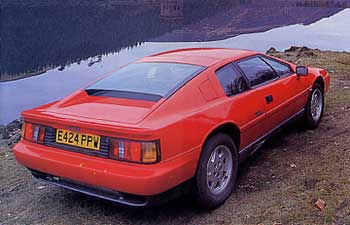
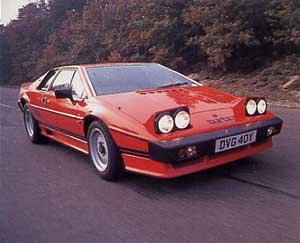
Above right: In 1987 Giugiaro original sharp lines were smoothed away by Lotus designer Peter Stevens to form the current model, which is even more aerodynamically efficient.
Above: One of the shortest-lived Esprit variants was the Turbo HC, the HC standing for the higher compression which, along with more boost and bigger Dellorto carburettors, helped give the car more power – 215bhp. It was superseded by the current model later that year. By 1987 a stronger, stiffer chassis and revised rear suspension greatly improved the Esprit’s handling, and meant that the driver could exploit the power of the 2.2 litre turbo to the full.
Driving the Esprit: stunning performance
The Esprit Turbo SE has a mixture of feelings in the cabin – dramatically low and compact in finest street racer tradition, expensively trimmed with leather and walnut, yet still with a less than perfectly integrated overall style and some recognisably parts-bin minor controls. It is a real driver’s car, locating you firmly in well-shaped seats between massive centre tunnel and deeper outer sills. The driving position is laid back and the controls all have the weight that tells you it is a car to be respected. That is instantly confirmed by the performance, which is now well and truly in the supercar league. The level of grip on specially developed Goodyear Eagle tyres is far higher even than on any previous Esprit, but the best part is the suspension’s all-round brilliance – a comfortable ride with remarkable control and limits that wouldn’t have disgraced a Grand Prix car only a few years ago. To the ears it might not have the drama of some of its Latin and German contemporaries, but in every other respect it compares with the very best. That has been achieved with minor revisions to spring and damper rates and, curiously, a slight increase in ride height. Unless you drive an F40 or 959, you won’t be able to rival the Esprit for sheer cornering power.
Lotus Esprit Turbo SE
The Esprit was designed by Giorgetto Giugiaro and the prototype shown at the Turin Show in 1972. Initially the design did not meet with Colin Chapman’s approval, but he was soon won over. It was designed to take Lotus from the Sports car bracket into the supercar league and did that with progressive updates: the original two-litre car had only 160 bhp, but power output rose progressively over the years. The series 2 car, introduced in 1979, was still a two litre, but the 2.2 Turbo of 1980 took power up to 215bhp. That in turn was boosted even further by the more efficient intercooled SE, with a massive 264 bhp. There has been one really major change in appearance over the years, when Giugiaro’s original sharp-edged designed was softened to the current, more rounded shape in 1988.
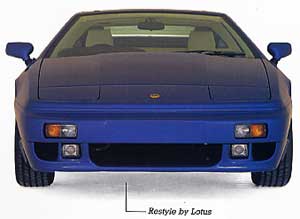
Lotus Esprit Data File
The first production Esprit, retrospectively the S1, appeared in May 1976, eight months after pre-production showings at the Paris and London shows, and five years after the first Ital styling exercise. Giugiaro’s sharp-edged wedge, with its dramatically raked windscreen, had changed only a little, to improve aerodynamic stability, to meet road-going legislation and to make the shape suitable for Lotus’s production methods; the distinctive ridge around the waist conceals the line where top and bottom halves of the shell (initially self-coloured, later spray painted) are joined. It now has a purpose-built backbone chassis rather than the stretched Europa unit of the prototype, with a 160bhp, Dellorto-carburetted version of the Lotus four cylinder engine, mounted amidships and canted at 45 degrees. It sat on wide, Wolfrace wheels with Opel-based double wishbone front suspension and rear semi-trailing arms – using the driveshaft as an upper suspension link, a design that was never entirely successful. As launched, it was considerably more expensive that Lotus has first planned, not so quick, and with a fair share of minor problems, but it began to sell strongly alongside its front-engined cousins.
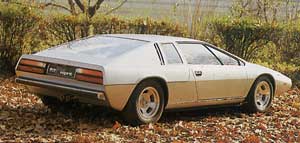
Giugiaro’s prototype Esprit appeared first at the 1972 Turin Show, based on a stretched Lotus Europa chassis. The back of the car lifted up to reveal the engine.

The production Esprit differed from the prototype in various ways, including having a distinct side ridge where the two halves of the shell are joined. The first production Esprit was introduced in 1976.
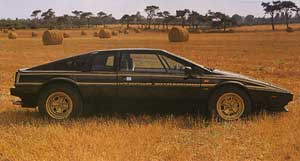 In 1978 Lotus introduced a celebratory model of the Esprit to commemorate Mario Andretti’s Formula 1 Championship.
In 1978 Lotus introduced a celebratory model of the Esprit to commemorate Mario Andretti’s Formula 1 Championship.
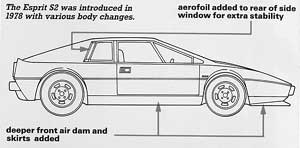 The normally-aspirated S3 Esprit, introduced a year after the Turbo, benefited from all the Turbo’s chassis improvements.
The normally-aspirated S3 Esprit, introduced a year after the Turbo, benefited from all the Turbo’s chassis improvements.1978 Esprit S2
The first updating of the Esprit came in August 1978, but it was minor surgery on a tight budget, aimed at tackling some of the early criticisms. Those had included dubious build and trim quality, lack of power to match the car’s dramatic looks and an unpleasant steering feel.Visibly, the car gained a new, integrated front air-dam, cooling scoops aft of the rear quarter windows and new alloy wheels, Inside, both trim and instruments were improved. The engine gained new cams and the front suspension geometry was subtly revised to give a more consistent feel. The changes were at least partly successful, with slightly better performance, considerably better steering and a bit more comfort. Refinement was still lacking, however, especially in the amount of road noise generated by the original rear suspension with its driveshaft as the top link.
In January 1980, Lotus made a more fundamental attack on the Esprits lack of midrange power, introducing a longer-stroke version of the four-cylinder twin-cam engine, which took capacity up from 1973cc to 2174 cc and gave the latest model the type number S2.2, for 2.2 litres. Maximum power didn’t increase, but peak torque did, from 140 lb ft to 160 lb ft at 5,000 rpm — still rather high up the scale for true flexibility but with a bit better spread lower down, It was a step in the right direction, but it can be regarded as the last of the first-generation; much bigger changes were on their way.
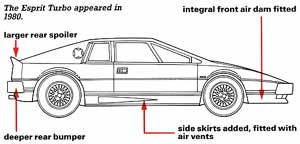
Left: The first Esprit Turbo appeared in the flamboyant lively of the Essex Petroleum company, who sponsored the Lotus Formula 1 team at the time. To cope with the extra power it was given larger air-dams and wings along with deep side skirts.
1980 Turbo Esprit
In February 1980, Lotus’s enigmatic Grand Prix sponsor Essex Petroleum held a huge party in the Albert Hall in London to outline their racing plans, and at the same time Lotus unveiled a new and even more dramatic-looking Esprit in Essex’s dark metallic blue, red and silver colours, The new look by Giugiaro, was chunkier and more aggressive than the delicate original, with big front and rear air-dams, a louvred rear window, a spoiler across the tail and deep, wide side-skirts with cooling ducts, This wasn ‘t just a cosmetic lob, though; under the skin was a greatly strengthened chassis with improved front and a totally redesigned rear suspension, at last with a top link to take the load from the driveshafts. Tyres were much wider, on new alloy wheels, the front brakes were bigger, and everything pointed to more power. The car certainly had that; up to 210bhp and 200 lb ft of torque thanks to the addition of a Garrett T3 turbocharger on a heavily revised version of the 2.2-litre four. This Turbo Esprit (now claimed to be a 150-mph-plus car) was originally offered only in Essex colours, with very high-spec trim and at a staggeringly high price, but in April 1981 Lotus offered more basic trim and conventional colours for a great deal less money, and the Turbo Esprit became their best-seller.
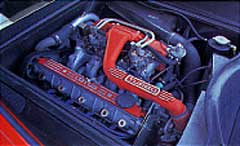
Above left: The Turbo Esprit engine before the latest SE modifications. Above right: The first-generation Esprit Turbo was powered by a 210-bhp version of the stretched 2.2-litre four-cylinder twin-cam giving 150-mph performance.
1981 Esprit S3
In March 1981, the chassis improvements introduced on the Essex Turbo Esprit filtered down to the humbler non-turbo model, transforming the S2.2 into the vastly better S3. The S3 had a stronger chassis and the new top-link rear suspension while retaining the familiar 2.2-litre unblown four, and as such it was hugely more competent, with stiffer chassis and better noise and bump insulation and even better handling. It was also cheaper, as Lotus marketed the car aggressively in the quest for greater sales.
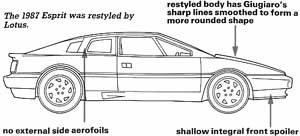
Above: The ¶normal’ Esprit Turbo can be distinguished by the lack of a rear wing; it’s still capable of 150mph, though.
1987 Esprit and Esprit Turbo
The Turbo Esprit had quite a long run before it next changed and was given even more power, in February 1987. The changes were quite major: a smaller and more responsive turbo but with higher boost, bigger Dellorto carburettors; improved cylinder head porting and exhaust manifold and a higher compression ratio — this last giving the new label ‘HC’. Power went up only slightly, from 210 to 215 bhp, and torque improved from 200 to 220 lb ft, with a much better spread and better throttle response.
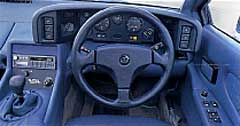
Right: The latest leather-clad interior is a world away from the original cabin of the early 1970s, which all too clearly betrayed Lotus’s kit-car heritage. Left: The rear wing and smooth bodywork show that this is the extremely quick SE version of the latest Esprit Turbo.
In October 1987 at the London Motor Fair, the Esprit changed almost everything except its name. It had a new body, a new interior, further chassis updating including better brakes and a Renault transaxle in place of the old Citröen type, and a completely new character. The restyling was done in-house, by a team headed by chief designer Peter Stevens. Although virtually all the main dimensions are practically unchanged, the car looks totally different, with a new and beautifully integrated softness of line replacing the old angulanty. It gives the car a more substantial look while remaining recognisably Esprit, and the new shell is both easier to make and markedly stiffer than the old, and this further improves the whole car. The 215bhp Turbo differs from the 172-bhp non-turbo in having a three-quarter window between the rear buttresses, a small rear lip spoiler and a deep rear air-dam, all of which led to substantially better aerodynamics.
1989 Esprit Turbo SE
In May 1989 Lotus launched what is currently the ultimate Esprit, the Turbo SE - for Special Equipment. In the usual fashion, it is based on the current car but with improvements, and in this case some very dramatic ones. The front suspension has been tuned to improve the steering feel and reduce the often criticised excesses of understeer, there’s a lot more rubber on the road, aerodynamic improvements with a deeper nose section and a separate rear wing, and slightly better brakes. Most of all, there is a new version of the engine, with fuel injection, catalyst emission equipment for unleaded running, and what Lotus call a chargecooler’: a liquid-to-air intercooler to keep the compressed intake mixture cooler, denser and therefore capable of giving more power. More power for this engine means 264bhp at 6,600 rpm — or as much as 280bhp in short, high-boost bursts. Thus equipped, the latest Esprit will achieve more than 160 mph and is by far the best Esprit yet.
The latest version of the Lotus turbo has a top-mounted intercooler. Producing 264bhp at 6,500rpm from 2174cc, the SE version of the Lotus turbo engine produces more power per litre than any other production engine. This is achieved through a combination of four valves per cylinder, twin overhead cams, a high compression ratio and an intercooled Garrett T3OB turbocharger.Engine
By the most exotic supercar standards (where a dozen cylinders, four camshafts and lots of cubic inches are common credentials) an Esprit engine, with just four cylinders and a capacity of under 2.2 litres, might seem less than glamorous; but in Turbo SE form it packs a mighty punch. Lotus have kept faith with the inline-four ever since the early 1970s, and the SE is essentially descended from the first all-Lotus engine, launched in 1971 in the ill-starred Jensen-Healey. That engine in turn. was derived from a two-litre Lotus racing engine of the late 1960s, using a twin-cam Lotus cylinder head on a Vauxhall block.This version of the engine is all-alloy, with belt-driven overhead camshafts and four valves per cylinder; it was designed to be slanted at 45 degrees and could have formed half a V8 had finance allowed. In 1971 it displaced 1973cc and produced 140bhp on Dellorto carbs; in the new Elite in 1974 it offered 155bhp, then 160bhp in the 1975 Esprit. Along-stroke, 2174cc development appeared in 1980 with more torque but no more power and the 210bhp Turbo Esprit added a new dimension, keeping but strengthening the basic design. The 1991 Esprit Turbo SE, with Garrett TB03 turbo, liquid chargecooler, multi -point injection with extra injectors for high-boost running and electronic management, is the most potent yet, producing 264bhp at 6,500rpm and 261 lb ft of torque at 3,900rpm — or even more in short bursts.
Lotus Esprit Turbo SE Inline 4 turbo, 16v Ferrari 348 tb V8, quad-cam, 24v Honda NSX V6, twin-cam, 24v Nissan 300 ZX V6, twin-cam, 24v Porsche 911 Carrera 2 Flat-six, twin-cam
|
|